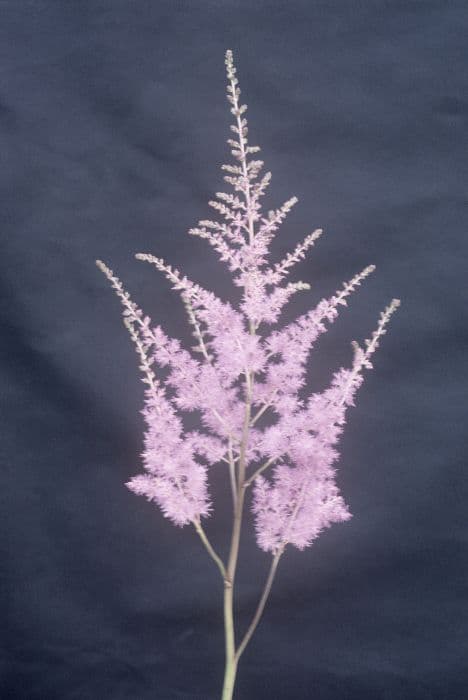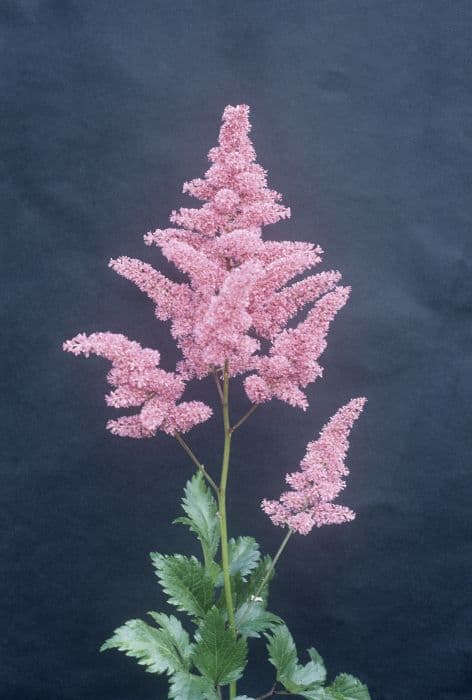Siberian tea Bergenia crassifolia

ABOUT
Commonly known as heartleaf bergenia, this plant weaves a tapestry of rich foliage and vibrant flowers in gardens. It is characterized by its leathery, dark green leaves that are heart-shaped. These leaves often turn to bronze or red hues in colder months, providing a touch of winter interest. When in bloom, it produces pyramid-shaped clusters of flowers that perch atop sturdy stems, varying in color from pinks to purples. The overall impression of heartleaf bergenia is one of robustness and color, with a progression of seasonal looks that keep it visually appealing throughout the year.
About this plant
 Names
NamesFamily
Saxifragaceae
Synonyms
Siberian Tea, Mongolian Tea, Leather Bergenia, Heartleaf Bergenia, Pigsqueak, Badan, Elephant's Ears, Winter-Blooming Bergenia
Common names
Saxifraga crassifolia, Bergenia cordifolia, Megasea crassifolia, Megasea cordifolia, Sedum crassifolium.
 Toxicity
ToxicityTo humans
Bergenia crassifolia, commonly known as Leather Bergenia, is not widely recognized as a toxic plant to humans. There is limited information on its toxicity, but it is generally not considered harmful if ingested in small quantities. However, as with many plants, it is possible that some individuals may have a sensitivity or allergic reaction to it. Ingesting large amounts of any plant material can potentially lead to gastrointestinal discomfort, nausea, or vomiting. It is always advisable to exercise caution and avoid eating plants that are not specifically grown for consumption.
To pets
Bergenia crassifolia, commonly known as Leather Bergenia, does not have a well-documented history of toxicity in pets such as dogs and cats. However, it is generally recommended to prevent pets from ingesting plants that are not intended for animal consumption, as they could potentially cause gastrointestinal upset. If a pet does consume Leather Bergenia and shows any signs of distress, such as vomiting, diarrhea, or unusual behavior, it is wise to consult a veterinarian for proper assessment and care.
 Characteristics
CharacteristicsLife cycle
Perennials
Foliage type
Evergreen
Color of leaves
Green
Flower color
Pink
Height
1-2 feet (30-60 cm)
Spread
1-2 feet (30-60 cm)
Plant type
Herb
Hardiness zones
3
Native area
Asia
Benefits
 General Benefits
General Benefits- Aesthetic Appeal: Bergenia crassifolia, commonly known as leather bergenia, adds visual interest to gardens with its large, glossy leaves and pink or white blooms that appear in early spring.
- Ground Cover: Due to its dense foliage, leather bergenia is effective at suppressing weeds, thus reducing the need for manual weeding.
- Drought Tolerance: Once established, leather bergenia is relatively drought-tolerant, making it suitable for xeriscaping and low-water-use landscapes.
- Cold Hardy: It can survive in colder climates, which makes leather bergenia a versatile plant for different regions.
- Pollinator Friendly: The flowers of the leather bergenia attract pollinators such as bees and butterflies, contributing to the health of local ecosystems.
- Low Maintenance: Leather bergenia requires minimal care once established, as it is mostly free from pests and diseases.
- Soil Erosion Control: The plant's thick root system helps stabilize soil and prevent erosion, especially on slopes or in areas with loose soil.
- Year-Round Interest: With evergreen leaves in many climates, leather bergenia provides year-round greenery and texture in the garden, even when not in bloom.
- Container Gardening: Due to its compact nature, leather bergenia is suitable for container gardening and can be placed on patios, balconies, or terraces.
 Medical Properties
Medical Properties- Anti-inflammatory: Bergenia crassifolia has been used to reduce inflammation.
- Antimicrobial: It possesses antimicrobial properties, which can inhibit the growth of certain bacteria and fungi.
- Antioxidant: The plant is known to contain antioxidants that help in protecting cells from damage caused by free radicals.
- Astringent: The astringent properties of Bergenia crassifolia can help in reducing bleeding and treating wounds.
- Diuretic: It may act as a diuretic, helping in the excretion of excess fluids from the body.
- Expectorant: Bergenia crassifolia has been used to help in expelling mucus from the respiratory tract.
- Litholytic: The plant can potentially aid in dissolving kidney stones.
- Antitussive: It may have cough-suppressant properties.
 Air-purifying Qualities
Air-purifying QualitiesThis plant is not specifically known for air purifying qualities.
 Other Uses
Other Uses- Bergenia crassifolia, commonly known as 'Pigsqueak' for its squeaky leaves, can be used to create unique sounds for theatrical performances or sound productions.
- The large leaves of Pigsqueak are sometimes utilized as natural wrappers for small packages or to wrap food for cooking, similar to how banana leaves are used in some cultures.
- Pigsqueak leaves have been traditionally used as book covers or as a natural parchment for writing in some regions, providing a rustic and unique medium.
- Due to their texture, Pigsqueak leaves can serve as a natural abrasive for light cleaning tasks or to polish soft metals when chemical abrasives are not desired.
- The flowers of Pigsqueak can be used to make natural dyes for textiles, providing a range of colors from green to yellow, depending on the mordant used.
- Pigsqueak is sometimes incorporated into floral arrangements or used as a decorative plant due to its attractive foliage and long-lasting flowers.
- In garden design, Pigsqueak is effectively utilized for groundcover to prevent soil erosion or as a border plant due to its robust and spreading nature.
- The robust nature of Pigsqueak makes it suitable for crafting natural wreaths and other decorative items, particularly in winter when other vegetation may be scarce.
- Pigsqueak can be planted on green roofs, contributing to urban biodiversity and insulation due to its hardiness and low maintenance requirements.
- Its evergreen leaves make Pigsqueak a valuable element in creating winter gardens and providing year-round greenery in temperate climates.
Interesting Facts
 Feng Shui
Feng ShuiThe plant Bergenia crassifolia, commonly known as Siberian tea, is not used in Feng Shui practice.
 Zodiac Sign Compitability
Zodiac Sign CompitabilityThe plant Siberian tea is not used in astrology practice.
 Plant Symbolism
Plant Symbolism- Tenacity: The Bergenia crassifolia, commonly known as Siberian tea, is known for its ability to withstand harsh conditions and is often a symbol of tenacity and endurance.
- Adaptability: As Siberian tea can thrive in various climates, it represents adaptability and the ability to prosper in different environments.
- Protection: The thick, leathery leaves of the Siberian tea plant signify protection and safety, often used in traditional medicine for its healing properties.
- Longevity: Since Siberian tea is a perennial plant that comes back year after year, it symbolizes longevity and the passage of time.
 Water
WaterFor Bergenia crassifolia, commonly known as Heartleaf Bergenia, water when the top inch of soil feels dry, typically once a week. They require consistent moisture but do not like to be waterlogged. Ensure that the plant is in well-draining soil, and provide about 16 ounces of water each time for a medium-sized pot, adjusting for pot size and environmental conditions. During the winter, reduce watering frequency as the plant enters a dormancy period. Over-watering can lead to root rot, so it's better to err on the side of underwatering rather than overwatering.
 Light
LightHeartleaf Bergenia thrives in partial shade but can tolerate full sun in cooler climates. The best spot for this plant is one where it receives dappled sunlight throughout the day or is shaded during the hottest part of the afternoon. Direct harsh sunlight can scorch the leaves, while too much shade can lead to leggy growth and fewer flowers.
 Temperature
TemperatureHeartleaf Bergenia is a hardy plant that can survive in temperatures ranging from 20°F to 85°F, making it suitable for many garden environments. However, the ideal temperature range for this plant to thrive is between 60°F and 75°F. It's important to protect the plant from extreme cold and frost, which can damage or kill the foliage.
 Pruning
PruningHeartleaf Bergenia should be pruned to remove spent flower stalks and damaged or yellowing leaves, enhancing the plant's appearance and preventing disease. Pruning is best done after the flowering period, usually in late spring or early summer. A yearly pruning to shape and tidy up the plant is often enough to maintain its health and vigor.
 Cleaning
CleaningAs needed
 Soil
SoilThe best soil mix for Bergenia, commonly known as Heartleaf Bergenia or Elephant's Ears, should be well-draining, loamy, and enriched with organic matter. The soil pH should ideally be slightly acidic to neutral, ranging from 5.5 to 7.0. A mix of two parts garden soil, one part peat moss, and one part perlite or sand is suitable.
 Repotting
RepottingHeartleaf Bergenia should be repotted every 2 to 4 years to refresh the soil and encourage healthy growth. The best time for repotting is in the spring or early summer, avoiding the colder months when the plant is less active.
 Humidity & Misting
Humidity & MistingHeartleaf Bergenia thrives in average room humidity levels. It is a versatile plant that adapts well to most indoor humidity conditions, making it relatively easy to maintain without the need for special humidity adjustments.
 Suitable locations
Suitable locationsIndoor
Place Heartleaf Bergenia in bright, indirect light indoors.
Outdoor
Plant Heartleaf Bergenia in partial shade, with moist soil.
Hardiness zone
3-8 USDA
 Life cycle
Life cycleBergenia crassifolia, commonly known as heartleaf bergenia or pig squeak, typically begins its life cycle when the seeds germinate in late spring after experiencing cold stratification, which is a period of cold temperature required for dormancy break. The seedlings develop into rosettes of leathery, heart-shaped leaves that can persist through the seasons due to the plant's evergreen nature. In the following spring, mature plants produce stout flowering stems that bear clusters of pink to red flowers, depending on the variety. After pollination, typically by bees, the flowers develop into capsules containing numerous tiny seeds. During the growing season, Bergenia crassifolia can also propagate asexually through the division of its rhizomes, which allows for the spread of the plant within an area. The perennial nature of heartleaf bergenia ensures it continues to grow year after year, with the leaves sometimes taking on reddish or purplish hues in the cooler autumn months.
 Propogation
PropogationPropogation time
Spring to Summer
Propogation: Bergenia crassifolia, commonly known as Heartleaf Bergenia or Leather Bergenia, is generally propagated through division, which is the most popular method. This is best done in the later parts of winter or early spring just before the new growth begins. To propagate by division, a mature clump should be carefully lifted from the ground and the root ball should be divided into smaller sections using a sharp spade or knife, ensuring that each section has at least one growth bud. The newly created divisions should then be replanted at the same depth they were growing previously and spaced approximately 12 inches (about 30 centimeters) apart to allow sufficient room for growth. It is important to water the divisions thoroughly after planting to help establish them.









